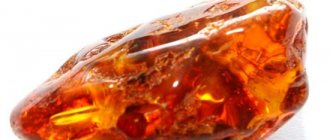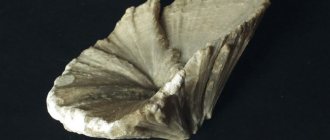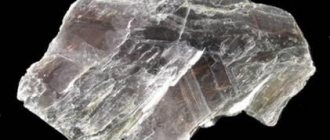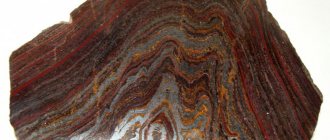Rock salt (halite, Halite) is one of the most common minerals on earth. The chemical formula of NaCl is sodium chloride. A substance of natural origin, the main deposits are concentrated in places where in ancient times there were seas and oceans. The formation of new deposits occurs constantly; salt lakes, seas, and estuaries are potential deposits. At the moment, elite varieties of table salt are mined in existing lakes, and the underlying reserves are a zone of halite formation.
Story
The term “halite” is translated from ancient Greek as “stone made of salt.”
The origin of the mineral dates back to the times when a proto-ocean was formed on the planet. Its salty water became the source of biological processes on Earth.
Halite deposits on the bottom of a dry lake in Death Valley (California)
The meaning of salt was understood by the inhabitants of ancient Greece and Rome, where the mineral served as money.
On the territory of the Russian Empire, the history of salt is rich:
- According to chronicles, its mining and trade flourished a thousand years ago.
- The imposition of exorbitant taxes on salt provoked the salt riots of 1648.
- The state monopoly on salt production was established by Peter I. Only a century and a half later, from 1862, Emperor Alexander II signed a decree on “demonopolization.” Salt mining became available to the entrepreneurs of that time.
Today Russia occupies 19th place in the world ranking of salt producers.
Origin of salt deposits
Salt deposits were formed many millions of years ago. According to scientists, the world's reserves of halite are 24 x 10 x 15 tons.
In nature, at the bottom of sea basins, less often large druses and shapeless masses, rock salt is found in the form of plates, and in fossil sediments - in the form of continuous masses.
It is formed as a result of exogenous processes - drying out of reservoirs, evaporation of water under the sun's rays. In deserts, salt marshes are often found - patches of salt formed as a result of drying out moisture. They disappear after precipitation and then form again.
Small amounts of the mineral are deposited on the walls of volcanic craters.
Variety and grind
Halite is divided into highest, first and second grade depending on the NaCl content.
The grinding of halite is no less important.
| Name | Size | Norm, % |
| Type A | Up to 1.2 mm, no less Over 2.5 mm, no more | 85,0 15,0 |
| Type B | Up to 2.5 mm, no less Over 4.5 mm, no more | 80,0 10,0 |
| Type C | Up to 4.5 mm, no less Over 4.5 mm, no more | 85,0 15,0 |
| Type D | Up to 40 mm | 100,0 |
Popular message topics
- Flax
Flax is a plant with a thin green stem. Despite the fact that flax is a perennial herb, it is harvested every year and sown again next year. There are more than 100 varieties of flax. The most common of them is common flax. - Pushkin in the village of Mikhailovskoye
The exile of the poet to his mother’s family estate in the village of Mikhailovskoye followed immediately upon his return from southern exile. While in exile in Odessa, Pushkin wrote the ode “Liberty,” which the emperor did not like. - The city of Murmansk
Murmansk is located in North-Eastern Europe and is the largest city in the polar region by population. The city was founded in 1916, and until 1917 it bore the name Romanov-on-Murman.
Physico-chemical characteristics
In terms of its chemical composition, the mineral halite is sodium chloride with the simplest short formula.
Comparison of ray refraction in calcite and halite
| Formula | sodium chloride, NaCl |
| Color | colorless or white; impurities give blue, purple, pink, yellow and gray tints |
| Stroke color | White |
| Shine | Glass |
| Transparency | Transparent, translucent |
| Hardness | 2 |
| Cleavage | Perfect to the cube |
| Kink | Conchoidal |
| Density | 2.1 -2.2 g/cm³ |
| singonia | Cubic |
| Refractive index | 1,544 |
Rock salt is one of the oldest minerals
Several centuries ago, common salt was one of the most valuable commodities in world trade. In modern times, the relative value of salt has decreased markedly compared to other minerals. Oil, gas, and other resources filled the information space, and mentions of salt became quite rare. Meanwhile, in all spheres of human activity, salt continues to play a vital and difficult to replace role.
The meaning of salt
You may hear different names used for salt. The most commonly mentioned are rock salt and table salt. If we omit some nuances, which we will talk about below, then both rock and table salt are the same sodium chloride (NaCl). The importance of this chemical compound cannot be overestimated.
Naturally, first we should talk about rock or table salt as a food additive necessary for the human body. Normal functioning of the human body is simply impossible without rock salt. For example, gastric juice contains a significant amount of hydrochloric acid, and the main raw material for its production by the body is salt. Ions of various substances are involved in the transmission of impulses along nerve fibers and in the work of muscle tissue. This includes sodium ions, the main supplier of which is salt used in food. In addition, it contains, in the form of impurities, manganese, chromium, iron - trace elements that are absolutely necessary for humans.
As for industry, it is difficult to find an industry that is not directly or indirectly dependent on processed products obtained from ordinary salt itself. This is, for example, sodium metal, which is widely used in nuclear energy and aircraft manufacturing. It is impossible to do without salt in the production of soap and in the dyeing business. NaCl is also a raw material for the chemical industry. Chlorine, various sodas, caustic soda, hydrochloric acid - people get all this from rock salt.
Livestock farming, agriculture and municipal services, and the drilling industry will not be able to function without ordinary salt.
In percentage terms, the approximate distribution of all mined rock salt looks like this:
- the majority, about 60%, is consumed by the chemical industry as raw materials;
- approximately 25% is used in the food industry;
- the remaining 15% of consumption comes from utilities, agriculture and other areas of activity.
World consumption of rock salt is growing every year. Over the past seven years, the growth in production, and, consequently, consumption, has amounted to 5%.
History of rock salt mining.
The history of rock salt mining goes back not even centuries, but millennia!
The sea coast of modern Bulgaria - dome-shaped adobe ovens were discovered here, in which salt was evaporated. This saltworks dates back to the fourth millennium BC. Ancient sources contain references to salt mining in the 5th century BC. Salt mines dating back to the Bronze Age have been found by archaeologists in Austria.
Throughout all these millennia, the work of a salt miner has been exceptionally difficult. A wheelbarrow, a pickaxe and a shovel were the tools used to mine rock salt. And only at the beginning of the twentieth century mechanization came to the salt fields.
In Russia, the first mention of salt fishing dates back to the 11th century. At the end of the 17th - beginning of the 18th centuries, salt production in Russia developed very widely. By the 19th century, annual production of rock salt reached 350,000 tons. And by the beginning of the 20th century, more than 1.8 million tons were mined annually in our country.
Now the annual volume of world salt production is approximately 210,000,000 tons, and this volume is constantly growing. The growth of consumption predetermines the need to develop production technology and improve processing. Today there are several ways to industrially produce salt.
Basin method of salt extraction
Huge, practically inexhaustible reserves of salt are contained in the water of the seas, oceans, and salt lakes. This salt is mined using the pool or self-planting method. Natural estuaries are separated from the sea by dunes or spits. In summer, when the weather is hot, the water in the estuaries evaporates intensively, and salt precipitates. Where there are no natural estuaries, artificial pools are built. The pools are filled with sea water. After this, their connection with the sea is stopped, and the evaporation process occurs similarly to natural in estuaries, under the influence of the sun and wind. The precipitated salt is collected technologically. Equipment such as excavators, bulldozers, and, where necessary, hand shovels is used. This technology has remained unchanged for centuries. Mechanization only brought it to the modern industrial level. However, in the total volume of salt produced, this method takes only second place.
Mining fossil salt
In the first place is the extraction of fossil rock salt. Solid salt in the bowels of the Earth is otherwise called “halite”. Underground salt deposits formed hundreds of millions of years ago on the site of ancient seas and oceans. These rocks can be either colorless or snow-white. But more often, impurities color halite in different colors: clay impurities give it a gray color, iron oxides - yellow or red, the presence of bitumen - makes the rock brown.
The development of fossil salt does not depend on the time of year and weather conditions, so more than 60% of world production comes from them. Underground deposits of rock salt can reach depths of 7-8 kilometers, and reach the very surface, forming above-ground domes.
Deposits with a depth of up to one hundred meters are developed by open-pit or open-pit mining. Having removed the top layer of soil and the rocks covering the salt deposits, you can begin the direct extraction of salt. The explosive, mechanical method or their combination is used. With the explosive method, holes are drilled in rock salt layers, explosives are placed, and by the force of the explosion, pieces of the salt layer break off from the main mass. In the mechanical method, special equipment is used to destroy the massif: excavators, graders, winches, etc. The open-pit mining method ensures the most complete extraction of minerals, has the lowest cost and the greatest safety. The disadvantages of quarrying are that the mined rock salt is susceptible to contamination by sediments, groundwater, and dust deposits.
The deeper the quarry becomes, the less pronounced the advantages of this mining method become. Especially its profitability. At a certain stage, the profitability of quarrying becomes equal to the profitability of mining using the shaft method. Then, to improve the quality of the extracted salt, they switch to the latter.
When deposits are located at a depth of more than a hundred meters, the mine method is used to extract rock salt. At the moment, the single-horizon method of opening has displaced all others from salt mines. It does not require a large amount of capital work, it is quite simple and versatile. However, with significant deepening of workings, there is a need to organize multi-stage transport lifts and powerful ventilation systems.
A salt mine is a tunnel in the thickness of a salt layer. Chambers extend from it on the sides, from which the main selection of rock salt is made. Each chamber reaches a length of up to 500 meters. The width and height of the chambers are 30 meters each. The chamber system does not require securing excavations. The absence of the need to secure the roof reduces the cost of extracted salt and increases labor productivity. Large mined-out spaces in the chambers make it possible to use mining equipment with high productivity and power. Scraper installations, electric locomotives, road boring machines are widely used in salt mines. The exhausted chambers are successfully used for the safe disposal of industrial waste.
Along with the described advantages, the chamber system also has disadvantages. Large volumes of mined-out spaces lead to ventilation problems. In addition, more than half of the salt reserves remain in the spaces between the chambers (pillars), sometimes up to 70%.
It should be noted that most mining enterprises practice exclusively machine mining. However, in some cases a less advanced drilling and blasting method is used. Drilling pits, laying explosives and subsequent explosive rock fall give much less efficiency and productivity. At the same time, the level of labor safety is significantly lower.
Leaching mining method
The essence of this method is as follows:
- in the explored salt formation, wells of the required depth and in the required quantity are drilled;
- fresh water heated to a high temperature is pumped into the wells;
- this water dissolves the salt;
- the liquid brine solution is pumped to the surface by slurry pumps;
- the salt slurry ends up in special sealed tanks with reduced pressure;
- due to low pressure, intense evaporation of water occurs;
- The salt settled at the bottom of the tanks is crushed by a centrifuge.
Due to its use in low-pressure tanks, this method is also called vacuum. Its advantages include low cost, especially when extracting salt from great depths. The disadvantages are high requirements for the chemical and mechanical stability of pumps due to the aggressiveness of the saline solution.
Explored world salt reserves and deposits
The world's reserves of rock salt are so huge that it is impossible to calculate their exact quantity.
Each cubic meter of water in the world's oceans contains about 27 kilograms of sodium chloride. If all the salt contained in the waters of lakes, seas and oceans is evenly distributed over the surface of the Earth, then the thickness of the salt layer will reach 45-50 meters.
Underground reserves of solid salt, according to the most rough estimates, are at least 3.5-4 * 1015 tons. If current production volumes are maintained, fossil reserves alone will last for at least fifteen thousand years.
In Europe, the largest salt deposits include the German Statfurt basin, the Slavyano-Artemovskoye and Prikarpatskoye deposits in Ukraine. In North America, there are large deposits in the USA (Kansas and Oklahoma) and the Canadian Saskatchewan basin.
On the territory of the Russian Federation there are reserves of table salt, the largest explored in the world.
In first place is Lake Baskunchak in the Astrakhan region. This unique deposit has been known since the 17th century. Its uniqueness lies in the fact that its salt reserves are replenished from the sources that feed the lake. According to geologists, the depth of the salt layers here reaches a record ten kilometers. On Lake Baskunchak, 930,000 tons of table salt are mined per year.
Nearby, in the Volgograd region, there is Lake Elton. There are also significant reserves of table salt.
The Sol-Iletskoye field has been developed in the Orenburg region for a long time. Back in the 18th century, the great Lomonosov examined samples of Iletsk salt. His notes have been preserved, in which he speaks extremely flatteringly about the quality of this salt. Here is the Iletsksol JSC plant, the largest in Russia (83%) in terms of the volume of underground mining of fossil halites. According to the project, the annual production capacity of the Iletsksol plant is 2,000,000 tons. The salt from the local deposits is of the highest quality. It requires neither purification nor enrichment.
Another large deposit is Usolye, located in Yakutia, near Irkutsk.
In conclusion, I would like to add that there is definitely no threat of a shortage of rock salt to humanity.
| Sodium chloride | Potassium chloride | Calcium chloride | Magnesium chloride | Sodium sulfate | Potassium sulfate | Calcium sulfate | Magnesium sulfate | Insoluble substances | Water | |
| Stassfurt | 94,57 | — | — | 0,97 | — | — | 0,89 | — | 3,25 | 0,22 |
| Stassfurt | 97,55 | — | — | — | 0,43 | — | 1,01 | 0,23 | — | 0,30 |
| Inowraclav | 96,44 | — | — | — | — | — | 0,82 | 0,07 | 2,53 | 0,14 |
| Cardona | 97,87 | — | — | — | — | — | 0,30 | — | 1,90 | — |
| Wieliczka | 90,23 | — | — | 0,45 | — | 1,35 | 0,72 | 0,62 | 5,88 | 0,83 |
| Sumbakovaya salt | 97,90 | — | — | — | 0,04 | — | 1,01 | 0,05 | 0,72 | 0,23 |
| Bakhmutskaya salt | 96,00 | — | 0,18 | — | — | — | 0,62 | — | 0,08 | 3,10 |
| Perm salt | 94,56 | — | 0,20 | 0,06 | — | — | 0,30 | — | 0,08 | 0,75 |
| Perm salt | 97,72 | — | 2,23 | 0,06 | — | — | 1,47 | — | 1,15 | 3,85 |
What does halite look like?
Everyone knows what table salt looks like. But this is how it turns out after processing for consumption.
Natural halite is a colorless or grayish translucent agglomerate with a moderate glassy luster.
The color of the mineral is created by impurities:
- aluminosilicates – gray;
- sodium – orange;
- iron – from yellow to brown through red.
The snow-white appearance of halite is due to the smallest air bubbles.
Purple or blue halite is dangerous to humans.
Thanks to the blue tints, it is easy to distinguish specimens that have been exposed to radiation.
Additional Information
Halite stone was used to treat many diseases. Currently, salt is used to gargle. A special chemical composition has an antiseptic effect on the tonsils, freeing the lacunae from bacterial plaque, which is so important for sore throat.
Halite salt is mined all over the world. Deposits can be found almost everywhere, so at present this mineral is not in short supply. The use of rock salt is determined by its unique properties. It prevents the proliferation of viruses, bacteria and fungi.
Salt can leave the body through sweat, so when dehydration occurs as a result of vomiting or diarrhea, sodium chloride-based solutions are often prescribed, which promote fluid retention in the cells.
Any animal in the wild always finds salt deposits and eats them. If there is not enough salt in the diet, then blood pressure and the conduction of nerve impulses are significantly reduced. At the same time, the heart muscle weakens, which is extremely dangerous.
Of course, an excess of this natural substance is also harmful, so people with arterial hypertension should use it with caution. Sea water contains a large amount of halite, so if you accidentally cut yourself on a shell while swimming, there will be virtually no pain. This is explained by the fact that the composition of rock salt, which is contained in sea water, is similar to the chemical indicators of blood.
The saline solution, which is used as a basis for infusion of drugs, contains a large amount of halite. It is used to eliminate the consequences of poisoning. After all, during intoxication, a significant amount of such an important compound as sodium chloride is lost.
If there is not enough salt in the human body, muscle spasms and cognitive behavioral disorders may occur. In addition, a significant lack of such a compound can be fatal. A diet that excludes salt provokes serious consequences if followed for more than 10 days.
Where is it used?
Halite has found use among industrialists, medical workers and housewives.
Household sphere
Salt is a universal assistant in solving household problems:
- Unsalted food is tasteless and of little use. Sometimes it is enriched with iodine, which is important for maintaining health.
- It is added when washing colored clothes or bed linen to prevent fading.
- Salt (or soda can be used) to remove old dirt on dishes, porcelain, and neutralize the musty smell in the microwave or refrigerator.
- Easily dissolves fresh wine and ink stains.
- For women it is important as a natural effective skin scrub.
The annual consumption of table salt on the planet is seven million tons.
Another hundred million tons of halite are taken by industry.
Industry
Halite is widely used in various industries:
- Cleaning boilers and heating systems from scale at enterprises. At the same time, aquatic microorganisms are neutralized.
- When extracting oil in permafrost zones, they dissolve ice and soften the soil. To facilitate the extraction process, wells are filled with salt water.
- A component that increases the strength of sand-lime bricks.
- The source for the synthesis of caustic soda and chlorine, from which paper, plastic, glass, soap, and aluminum are then obtained.
- Cheap, environmentally friendly coating for icy roads.
Jewelers are not interested in the mineral. Collectors are delighted with unusual specimens of halite of various origins.
Where and how is salt mined?
Significant mineral deposits are located in Europe, South Asia and America. Important deposits in Russia:
- Iletskaya Zashchita - near Orenburg;
- Solikamsk - in the Perm region;
- Belbazhskoye field - in the Nizhny Novgorod region;
- Lake Baskunchak near the Volga.
Large deposits are located in Poland, Egypt, India, at the foot of the Himalayan mountains. To indicate deposits of stone halite on maps, it is customary to draw a white cube.
There are several ways to extract the mineral:
- mine - they lift whole monoliths from great depths;
- vacuum - fresh water is pumped into the well under pressure, then the saline solution is pumped out and the salt is evaporated from it;
- evaporation – seawater is taken and evaporated to produce salt and fresh water.
Salt production is one of the most significant areas of industry. About 100 million tons of rock salt are used worldwide every year.
In addition to the topic, video:
How to care
The mineral is fragile, dissolves in water, and has low hardness. Given these properties of halite, you need to care for it carefully:
- For collection material, select a personal, durable, ventilated box.
- Protect from moisture. The humidity in the room should also be lower.
- A glass, wooden, ceramic container or linen bag is suitable for storing kitchen salt. It is advisable to cover the salt shaker on the table.
To maintain condition, crystals or halite products are rinsed with a saturated saline solution or wiped with alcohol or gasoline. Then it is dried and polished with velvet cloth.
Field and production
Solid salt deposits are found in many regions of the world, where they lie at depths ranging from several hundred to more than a thousand meters. Special combines cut the salt layers underground, then the rock is transported to the surface of the earth through conveyors. After which, when it gets to the mills, it crumbles to obtain particles (crystals) of various sizes.
Mined in many countries. The largest producer is the USA (21%), followed by Japan (14%). In Russia, the breed is mined in the Urals and Eastern Siberia. Ukraine and Belarus also have large reserves.
Therapeutic effect
The healing power of halite has found application in home medicine:
- Gargle a sore throat or a sore tooth with salt water.
- A bag of hot salt is applied to sore spots for radiculitis.
- Placing it on the chest calms a severe cough.
Official medicine recognizes the influence of salt caves. Their microclimate is also recreated in special rooms.
Magic properties
Salt is a frequent character in fairy tales and legends. There it acts as a talisman against evil spirits and a love potion.
This is how the magical properties of white crystals became entrenched in people’s memory:
- A bag of salt was given as a protective talisman to a soldier, traveler, or merchant going to war or to distant lands.
- Witchcraft books contain many salt spells to protect against diseases, the evil eye, and damage. This talisman is especially suitable for children or energetically weak, suspicious people.
- There are recipes for a love spell or for gaining luck.
The simplest body amulet is a handful of salt in a linen bag. No one should see it: salt absorbs negativity. And this weakens the magic.
Spilled salt is considered a bad sign. This is not surprising: the sign was formed at a time when the price of crystals was equal to gold. It’s too early to drop a diamond into the sewer today and a quarrel is also guaranteed.
According to the Zodiac, halite suits everyone.
Product Quality Check
Checking the quality of industrial salt (as well as feed and table salt) is strictly regulated. Every serious salt producer develops technical specifications (TS) for salt and subsequently carefully monitors compliance with product quality requirements.
In general, mineral salt must meet the following parameters: odorless, but have a pronounced salty taste. The color may be white or grayish (sometimes with a yellow tint). The color of halite depends on the deposit where it is mined. But the amount of foreign impurities in industrial salt is strictly regulated. The product is a free-flowing crystalline substance. Sediment in water is allowed within certain limits.
The largest reserves of salt in the world are in Lake Baskunchak
When purchasing halite, you should keep in mind that products for municipal services are subject to seasonal price increases. Demand for halite as a road reagent increases sharply from November to February. Thus, the most profitable solution in economic terms would be to purchase halite before the onset of frost.











